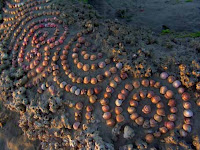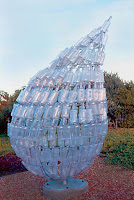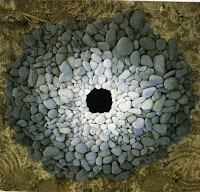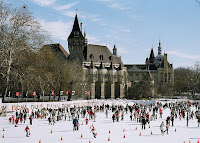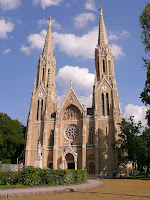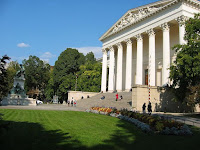-Whole Territory of it is 100,000 And 52,000 are in Hungary.
- This scenery is the most extended in Hungary.
-The most uniform in a way of relief and climate.
-Large part of it is perfect plain. perfect plain: where the distance between the lowest and the highest point is smaller than 100 m.
-Landscape of it was transformed by people. - deforestation /from the early Middle Ages/
-control of the Tisza and its tributaries/ 19th century / (mellékfolyók)
-So the characteristic Hungarian landscape, the “puszta” is not a natural landscape of the territory, but it was formed by human.
Parts of the Great Plain:
4.-Beregi-Plain 1. loess (hordalékkúp)
-Beregi-Tiszahát (löszös hordalékkúp)
-Szatmári-Tiszahát 2. sandy (hodalékkúp)
4.-Szatmári-Plain 3. drained marsh ->
3.-Ecsedi-moor (láp) ->meadow, pasture
2.-Nyírség 4. flood-basin (ártér)
-Hajdúság
4.-Bodrog-köz
-Rét-köz
4.-Takta-köz
-Hortobágy
-Nagykunság
3.-Nagy-Sárrét
3.-Kis-Sárrét
1.-Jászság
-Tiszazug
1.-Maros-Kőrös köze
2.-Kis-Kunság
1.-Solti-Plain
1.-Pesti-Plain
-Mezőföld
1.-Sárköz
-Drávamellék
National Parks of the Great Plain:-Hortobágyi
-Kiskunsági
-Körös-Maros
-Duna-Dráva
Characterization of some parts of the Great Plain:
We can divide the Great Plain into two parts on the basis of the catchment areas :(vízgyűjtő terület)
-Dunai Great Plain
-Tiszai Great Plain
Dunai Great Plain
Dunamenti-Plain:-it is near the Danube for 15-30 km
-Pesti-Plain: free of flood (ármentes)
-southern part extended flood-basin
-on the south, on the right side of the river is the Sárköz
Kiskunság:-it formed in the Pleistocene
-130-170 m high alluvial cone
-sandy soil
-there are dunes still in movement /Bugac, Fülöpháza/
Mezőföld: -covered by loess
-on the right-hand side of the Danube
-many landslides /Dunaújváros, Dunaföldvár/
Drávamellék:-on both side of the river
-only the left-hand part is in Hungary
-mediterranean climate
-the most precipitation of the Great Plain /700 mm/year /
Tiszai Great Plain
Tiszamente:
-artificial ox-bow lakes are frequent
-15-25 km wide
Jászság:-near the lower course (alsó folyás) of the Zagyva
Nyírség:
-covered by sand
-there is the highest point of the Great Plain: Hoportyó-183 m
Hajdúság:
-covered by loess
Hortobágy:
-important touristic centre
-it is a part of the World Heritage
Nagykunság:
-the driest part of the country /less than 500 mm/year/
Körös region:
-perfect plain
-there were marshes
-now: meadows, pastures
Maros-Körös köze:
-covered by loess
-its south eastern part is the hottest part of the country /annual mean temperature is 11°C, mean temperature in July is 22°C/
- This scenery is the most extended in Hungary.
-The most uniform in a way of relief and climate.
-Large part of it is perfect plain. perfect plain: where the distance between the lowest and the highest point is smaller than 100 m.
-Landscape of it was transformed by people. - deforestation /from the early Middle Ages/
-control of the Tisza and its tributaries/ 19th century / (mellékfolyók)
-So the characteristic Hungarian landscape, the “puszta” is not a natural landscape of the territory, but it was formed by human.
Parts of the Great Plain:
4.-Beregi-Plain 1. loess (hordalékkúp)
-Beregi-Tiszahát (löszös hordalékkúp)
-Szatmári-Tiszahát 2. sandy (hodalékkúp)
4.-Szatmári-Plain 3. drained marsh ->
3.-Ecsedi-moor (láp) ->meadow, pasture
2.-Nyírség 4. flood-basin (ártér)
-Hajdúság
4.-Bodrog-köz
-Rét-köz
4.-Takta-köz
-Hortobágy
-Nagykunság
3.-Nagy-Sárrét
3.-Kis-Sárrét
1.-Jászság
-Tiszazug
1.-Maros-Kőrös köze
2.-Kis-Kunság
1.-Solti-Plain
1.-Pesti-Plain
-Mezőföld
1.-Sárköz
-Drávamellék
National Parks of the Great Plain:-Hortobágyi
-Kiskunsági
-Körös-Maros
-Duna-Dráva
Characterization of some parts of the Great Plain:
We can divide the Great Plain into two parts on the basis of the catchment areas :(vízgyűjtő terület)
-Dunai Great Plain
-Tiszai Great Plain
Dunai Great Plain
Dunamenti-Plain:-it is near the Danube for 15-30 km
-Pesti-Plain: free of flood (ármentes)
-southern part extended flood-basin
-on the south, on the right side of the river is the Sárköz
Kiskunság:-it formed in the Pleistocene
-130-170 m high alluvial cone
-sandy soil
-there are dunes still in movement /Bugac, Fülöpháza/
Mezőföld: -covered by loess
-on the right-hand side of the Danube
-many landslides /Dunaújváros, Dunaföldvár/
Drávamellék:-on both side of the river
-only the left-hand part is in Hungary
-mediterranean climate
-the most precipitation of the Great Plain /700 mm/year /
Tiszai Great Plain
Tiszamente:
-artificial ox-bow lakes are frequent
-15-25 km wide
Jászság:-near the lower course (alsó folyás) of the Zagyva
Nyírség:
-covered by sand
-there is the highest point of the Great Plain: Hoportyó-183 m
Hajdúság:
-covered by loess
Hortobágy:
-important touristic centre
-it is a part of the World Heritage
Nagykunság:
-the driest part of the country /less than 500 mm/year/
Körös region:
-perfect plain
-there were marshes
-now: meadows, pastures
Maros-Körös köze:
-covered by loess
-its south eastern part is the hottest part of the country /annual mean temperature is 11°C, mean temperature in July is 22°C/

